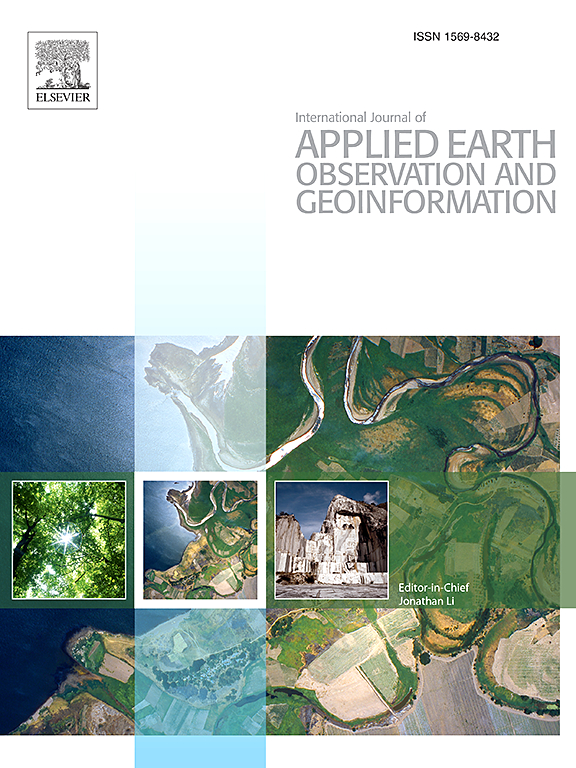A dual-branch spatio-temporal Transformer for enhancing cross-regional transferability of winter wheat extraction using small training datasets
IF 7.5
1区 地球科学
Q1 Earth and Planetary Sciences
International Journal of Applied Earth Observation and Geoinformation
Pub Date : 2025-08-10
DOI:10.1016/j.jag.2025.104785
引用次数: 0
Abstract
Accurate identification of winter wheat from remote sensing imagery is crucial for large-scale agricultural monitoring. Despite the success of Transformer-based deep learning models in various fields, their application in crop identification has been limited by the scarcity of extensive labeled training data. This study proposes a dual-branch spatio-temporal Transformer (DST-Transformer) for winter wheat extraction from Sentinel-2 imagery using a small training dataset. By independently extracting temporal and spatial features, the DST-Transformer effectively delineates crop boundaries and reduces misclassification. Experiments demonstrate its effectiveness with small training datasets, achieving over 90% overall accuracy (OA) and 88.25% mean intersection over union (MIoU) when evaluating on test datasets. The DST-Transformer was further applied to large-scale winter wheat extraction across Shandong Province, China (an area 66 times larger than the training region) to evaluate its cross-regional transferability. Evaluation results showed OA over 92% and MIoU exceeding 85% at all validation sites, highlighting the DST-Transformer’s robustness and strong generalization capability. This study underscores the DST-Transformer’s potential for large-scale crop identification and illustrates the promise of Transformer-based architectures for efficient, high-precision crop mapping with small training datasets, advancing the application of deep learning in agricultural remote sensing.基于双分支时空转换器的小数据集冬小麦提取跨区域可转移性研究
冬小麦遥感影像的准确识别对大规模农业监测至关重要。尽管基于transformer的深度学习模型在各个领域取得了成功,但由于缺乏广泛的标记训练数据,它们在作物识别中的应用受到限制。本研究提出了一种双分支时空转换器(DST-Transformer),用于使用小型训练数据集从Sentinel-2图像中提取冬小麦。通过独立提取时空特征,DST-Transformer可以有效地描绘作物边界,减少误分类。实验证明了该方法在小型训练数据集上的有效性,在测试数据集上评估时,总体准确率(OA)达到90%以上,平均交联率(MIoU)达到88.25%。将DST-Transformer进一步应用于中国山东省(面积为培训区域的66倍)的大规模冬小麦提取中,以评估其跨区域可转移性。评价结果显示,所有验证点的OA均大于92%,MIoU均大于85%,显示了DST-Transformer的鲁棒性和较强的泛化能力。该研究强调了DST-Transformer在大规模作物识别方面的潜力,并说明了基于transformer的架构在小型训练数据集上实现高效、高精度作物制图的前景,推动了深度学习在农业遥感中的应用。
本文章由计算机程序翻译,如有差异,请以英文原文为准。
求助全文
约1分钟内获得全文
求助全文
来源期刊
CiteScore
10.20
自引率
8.00%
发文量
49
审稿时长
7.2 months
期刊介绍:
The International Journal of Applied Earth Observation and Geoinformation publishes original papers that utilize earth observation data for natural resource and environmental inventory and management. These data primarily originate from remote sensing platforms, including satellites and aircraft, supplemented by surface and subsurface measurements. Addressing natural resources such as forests, agricultural land, soils, and water, as well as environmental concerns like biodiversity, land degradation, and hazards, the journal explores conceptual and data-driven approaches. It covers geoinformation themes like capturing, databasing, visualization, interpretation, data quality, and spatial uncertainty.

 求助内容:
求助内容: 应助结果提醒方式:
应助结果提醒方式:


